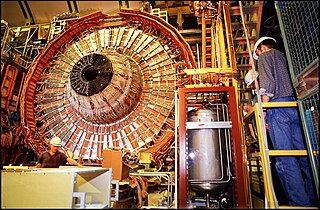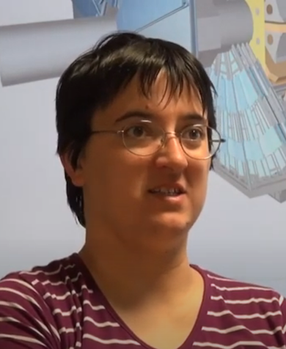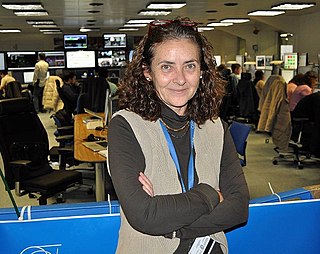
Particle physics or high-energy physics is the study of fundamental particles and forces that constitute matter and radiation. The field also studies combinations of elementary particles up to the scale of protons and neutrons, while the study of combination of protons and neutrons is called nuclear physics.

The European Organization for Nuclear Research, known as CERN, is an intergovernmental organization that operates the largest particle physics laboratory in the world. Established in 1954, it is based in Meyrin, western suburb of Geneva, on the France–Switzerland border. It comprises 23 member states. Israel, admitted in 2013, is the only non-European full member. CERN is an official United Nations General Assembly observer.

The Compact Muon Solenoid (CMS) experiment is one of two large general-purpose particle physics detectors built on the Large Hadron Collider (LHC) at CERN in Switzerland and France. The goal of the CMS experiment is to investigate a wide range of physics, including the search for the Higgs boson, extra dimensions, and particles that could make up dark matter.

ATLAS is the largest general-purpose particle detector experiment at the Large Hadron Collider (LHC), a particle accelerator at CERN in Switzerland. The experiment is designed to take advantage of the unprecedented energy available at the LHC and observe phenomena that involve highly massive particles which were not observable using earlier lower-energy accelerators. ATLAS was one of the two LHC experiments involved in the discovery of the Higgs boson in July 2012. It was also designed to search for evidence of theories of particle physics beyond the Standard Model.

The Large Electron–Positron Collider (LEP) was one of the largest particle accelerators ever constructed. It was built at CERN, a multi-national centre for research in nuclear and particle physics near Geneva, Switzerland.

DELPHI was one of the four main detectors of the Large Electron–Positron Collider (LEP) at CERN, one of the largest particle accelerators ever made. Like the other three detectors, it recorded and analyzed the result of the collision between LEP's colliding particle beams. The specific focus of DELPHI was on particle identification, three-dimensional information, high granularity (detail), and precise vertex determination.
The High Luminosity Large Hadron Collider is an upgrade to the Large Hadron Collider, operated by the European Organization for Nuclear Research (CERN), located at the French-Swiss border near Geneva. From 2011 to 2020, the project was led by Lucio Rossi. In 2020, the lead role was taken up by Oliver Brüning.

The MicroMegas detector is a gaseous particle detector and an advancement of the wire chamber. Invented in 1996 by Georges Charpak and Ioannis Giomataris, Micromegas detectors are mainly used in experimental physics, in particular in particle physics, nuclear physics and astrophysics for the detection of ionizing particles.
Joseph Incandela is an American particle physicist, a professor of physics at the University of California, Santa Barbara and currently based at CERN, where he spent two years as the spokesperson for the Compact Muon Solenoid experiment at the Large Hadron Collider.

Sir Tejinder Singh Virdee,, is a Kenyan-born British experimental particle physicist and Professor of Physics at Imperial College London. He is best known for originating the concept of the Compact Muon Solenoid (CMS) with a few other colleagues and has been referred to as one of the 'founding fathers' of the project. CMS is a world-wide collaboration which started in 1991 and now has over 3500 participants from 45 countries.

Sau Lan Wu is a Chinese American particle physicist and the Enrico Fermi Distinguished Professor of Physics at the University of Wisconsin-Madison. She made important contributions towards the discovery of the J/psi particle, which provided experimental evidence for the existence of the charm quark, and the gluon, the vector boson of the strong force in the Standard Model of physics. Recently, her team located at the European Organization for Nuclear Research (CERN), using data collected at the Large Hadron Collider (LHC), was part of the international effort in the discovery of a boson consistent with the Higgs boson.
Mayda Velasco is a physicist and professor in the Department of Physics and Astronomy at Northwestern University. She works in experimental particle physics and is a leading member of the CMS Collaboration at the CERN LHC. She founded COFI and is its first director. She is a pioneer in the physics potential of photon colliders.
Michel Della Negra is a French experimental particle physicist known for his role in the 2012 discovery of the Higgs Boson.

]
Tulika Bose is a professor of physics at the University of Wisconsin-Madison, whose research focuses on developing triggers for experimental searches of new phenomena in high energy physics. Bose is a leader within the Compact Muon Solenoid (CMS) experiment, a CERN collaboration famous for its experimental observation of the Higgs boson in 2012.

Stephanie Zimmermann was a German physicist who worked on the ATLAS experiment at the Large Hadron Collider at CERN. As a researcher from the University of Freiburg, she was involved in the Muon Detector Control System activities, and she served as muon run-coordinator. She was elected and served as ATLAS Run-Coordinator in 2012–2014. She then became Project Leader of the New Small Wheel project (NSW), part of an extensive upgrade, the largest phase 1 upgrade project for the ATLAS detector.

Teresa Rodrigo Anoro was a Spanish scientist who worked in particle physics. She worked at CERN, Fermilab and the Instituto de Física de Cantabria and was professor at the University of Cantabria. Whilst at CERN, Rodrigo worked on the Compact Muon Solenoid and research for the Higgs boson.

Bradley Cox is an American physicist, academic and researcher. He is a Professor of Physics and the founder of the High Energy Physics Group at the University of Virginia.
Steven Michael Errede is an American experimental physicist, known for his leadership in the collaboration that experimentally confirmed the existence of the top quark.
James Lewis Pinfold is a British-Canadian physicist, specializing in particle physics.











